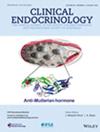Association Between Serum Uric Acid to Creatinine Ratio and Time in Range in Patients With Type 2 Diabetes
Abstract
Background
Elevated serum uric acid (SUA) levels are an important marker of metabolic disorders. However, SUA levels largely depend on renal clearance function. This study aims to investigate the correlation between serum uric acid to creatinine (SUA/SCr) ratio and time in range (TIR) in patients with type 2 diabetes mellitus (T2DM).
Methods
TIR was assessed using continuous glucose monitoring (CGM) systems in 514 hospitalized patients with T2DM. Biochemical parameters, including blood glucose, liver and renal function markers, and blood lipids, were measured. SUA/SCr was calculated, and its association with TIR was analyzed.
Results
One-way ANOVA revealed significantly higher TIR levels in the SUA/SCrQ3 group compared to the Q1 group (72.90% [60.08%, 83.38%] vs. 80.20% [70.25%, 89.65%], p = 0.0084). Smooth curve fitting and threshold effect analyses demonstrated an inverted U-shaped association between SUA/SCr and TIR after multivariable adjustment. Before the inflection point (SUA/SCr = 6.471), a positive correlation was observed (β = 1.402, p = 0.0379), indicating a 1.402% increase in TIR per 1-unit increase in SUA/SCr. Beyond the inflection point, a negative correlation emerged (β = −4.406, p = 0.0043), corresponding to a 4.406% decrease in TIR per 1-unit increase in SUA/SCr. Trend tests confirmed the statistical significance of these bidirectional associations. Interaction analyses indicated that gender, BMI, GLP1RA-therapy, SGLT2i-therapy did not significantly modify the SUA/SCr-TIR association (p > 0.05 for all). However, age significantly modified this relationship (P for interaction = 0.0240). Subgroup analysis by age revealed a curvilinear association in participants aged < 65 years, with no significant association below the inflection point (SUA/SCr = 6.559; β = 0.796, p = 0.2803) but a significant negative association above it (β = −4.392, p = 0.0059). No significant association was found in participants aged ≥ 65 years.
Conclusions
An inverted U-shaped association exists between SUA/SCr and TIR in patients with T2DM, suggesting that maintaining SUA/SCr within a certain range may be a protective factor for TIR.


 求助内容:
求助内容: 应助结果提醒方式:
应助结果提醒方式:


